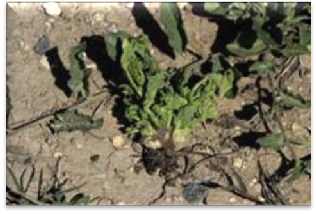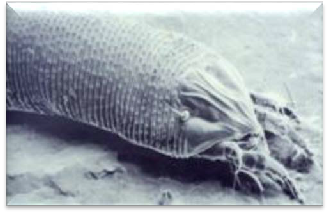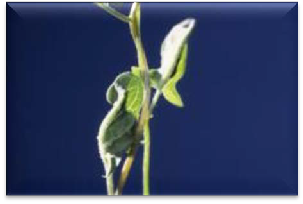Field Bindweed is a Class C Weed. The Class C status allows counties to enforce control if locally desired.
Other counties may choose to provide education and technical consultation.
Field Bindweed (Convolvulus arvensis L.) (creeping jenny) was introduced from Eurasia. It is a long-lived perennial with an extensive root system, reaching depths of 20 to 30 feet and repeatedly giving rise to numerous long rhizomes (horizontal roots). Field bindweed is a member of the morning-glory family and shares the family’s vine characteristics. The extensive root system and creeping growth habit of this weed form dense, tangled infestations. The  twining stems vary from 1 to 6 feet long. Leaf size and shape are variable, but generally are 1 to 2 inches long and are often sagittate (arrowhead-shaped). Flowers are approximately 1 inch in diameter, tubular or bell- shaped, and usually white, sometimes with a light pink pattern. Two tiny bracts appear on the stem, approximately 1 inch below the flower base. The small bracts, along with the leaf shape and smaller flower size, distinguish field bindweed from hedge bindweed. Seeds of field bindweed are dark, brownish-gray, about 1/8 inch long, and have one rounded and two flattened sides. Seed production varies depending on environmental conditions, ranging from 25 to
twining stems vary from 1 to 6 feet long. Leaf size and shape are variable, but generally are 1 to 2 inches long and are often sagittate (arrowhead-shaped). Flowers are approximately 1 inch in diameter, tubular or bell- shaped, and usually white, sometimes with a light pink pattern. Two tiny bracts appear on the stem, approximately 1 inch below the flower base. The small bracts, along with the leaf shape and smaller flower size, distinguish field bindweed from hedge bindweed. Seeds of field bindweed are dark, brownish-gray, about 1/8 inch long, and have one rounded and two flattened sides. Seed production varies depending on environmental conditions, ranging from 25 to  300 seeds produced per plant. With their tough coat, the seeds can remain viable in the soil for up to 50 years.
300 seeds produced per plant. With their tough coat, the seeds can remain viable in the soil for up to 50 years.
Field bindweed reproduces by seeds and regenerates new plants from adventitious buds on roots and rhizomes. It is spread by animals, drainage water and machinery, as well as a contaminant of crop seed. Field bindweed has become a problem in disturbed areas, pastures and cultivated fields – hence the Latin name arvensis, which means pertaining to fields. Dense field bindweed infestations can reduce crop yields by 50 to 60 percent.
Control Methods
To successfully manage field bindweed, it is necessary to contain and persistently control existing stands in order to exhaust the root system and deplete the soil seed bank. This weed needs to be continually stressed, forcing it to exhaust root nutrient stores and eventually die. Of all control methods, prevention is most important. It is essential to maintain healthy pastures and rangeland, minimizing bare spots, and to continually monitor property for new infestations.
Small grain, forage, and legume seed should be cleaned before planting to remove seed of bindweed and other weeds. Livestock feed should also be free of infested plants. If livestock ingest bindweed-infested feed, the manure should not be spread on bindweed- free land. Harvesting, tillage, and other machinery should be cleaned before it leaves a bindweed-infested field.
Cultural Control: Field bindweed prefers full sunlight and mesic to dry conditions. It has considerable drought tolerance, and flourishes in poor soil that contains sand, gravel, or hardpan clay. It will also grow in moist fertile soil, but dislikes competition from taller plants. Perennial plantings may discourage establishment of field bindweed. Rotations of tall, shade-producing crops can reduce bindweed problems, since the weed is not very competitive under shady conditions. Healthy, long-term stands of sod- forming grasses or dense plantings of bunch grasses and legumes can function as “smother crops.”
Mechanical Control: Field bindweed is difficult to control mechanically. Once cultivated, the plant will regenerate its shoot system in about 3 weeks. Thus cultivation should occur every 3 weeks. Such repetitive cultivation throughout the growing season for at least 2 years would be necessary to deplete the root system and provide control. This is likely not financially practical for most agricultural production systems. In general, mechanical control is not a good option because plants are able to reproduce from roots, and seed remains viable in the soil for long periods.
Chemical Control: Long-term control of field bindweed from herbicides depends on movement of a sufficient amount of herbicide through the root system to kill the roots and root buds. This requires use of systemic herbicides. Examples of systemic herbicides include 2,4-D, dicamba (Banvel/Clarity®), picloram (Tordon®), glyphosate (Roundup® or equivalent) and quinclorac (Drive®).
Quinclorac and picloram provide the most effective control of field bindweed. Review the label to identify which may be better in your management area. Contact herbicides such as paraquat kill only the tissue directly contacted by the herbicide, which results in only short-term control of topgrowth.
Chemical control of bindweed may damage desirable plants in areas of treatment. Application of glyphosate can provide good control, but only when applied at high rates and may be more effective in combination with other herbicides. The most effective time of application is during the early flowering period when moisture levels are low. Even at high rates of application, repeated applications may be necessary for adequate control.
Successful control of field bindweed requires a long-term management program. An herbicide applied once will never eliminate established stands; rather, several retreatments are required to control field bindweed and keep it suppressed. Because of long seed viability and tremendous food reserves stored in the roots, repeated chemical and/or mechanical control measures must be used.
More information can be found in the PNW Weed Management Handbook
Use pesticides with care. Apply them only to plants, animals, or sites listed on the label. When mixing and applying pesticides, follow all label precautions to protect yourself and others around you. It is a violation of the law to disregard label directions. Store pesticides in their original containers and keep them out of the reach of children, pets, and livestock.
Biological Control: Two biological control agents are available in the United States, but have not yet resulted in substantial field bindweed control and have not been successfully established in the Pacific Northwest. The bindweed mite, Aceria malherbae, feeds on the plant, causing deformed buds and leaves. The mite survives better in drier settings and is less effective in tall grass stands. Another insect cleared for release as a biocontrol agent is the European moth, Tyta luctuosa. Caterpillars of this moth defoliate bindweed, usually in the later part of the growing season.
Insect damaged plant
Enlarged A. malherbae
Field bindweed buds and leaves galled by
A. malherbae
Tyta luctuosa larvae
While livestock (cattle, sheep, goats) may graze field bindweed, even intensive grazing generally will not sufficiently stress the plant to prevent its recovery and will often result in the site being overgrazed, which is not desirable and tends to favor bindweed proliferation.
Questions: contact Steve Van Vleet or phone (509) 397-6290
Photo credits included in PDF




